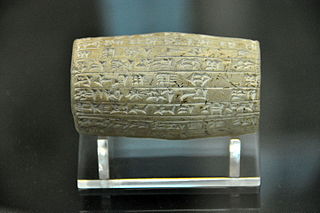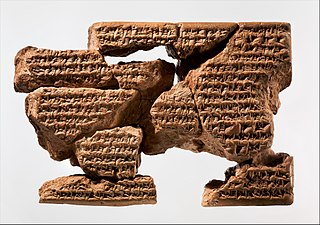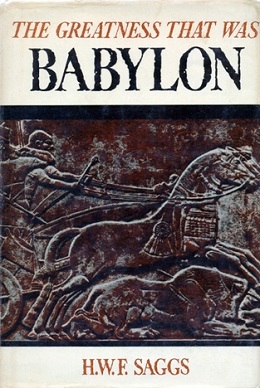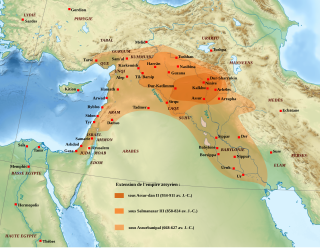Related Research Articles

Chaldea was a small country that existed between the late 10th or early 9th and mid-6th centuries BC, after which the country and its people were absorbed and assimilated into the indigenous population of Babylonia. Semitic-speaking, it was located in the marshy land of the far southeastern corner of Mesopotamia and briefly came to rule Babylon. The Hebrew Bible uses the term כשדים (Kaśdim) and this is translated as Chaldaeans in the Greek Old Testament, although there is some dispute as to whether Kasdim in fact means Chaldean or refers to the south Mesopotamian Kaldu.

Babylonia was an ancient Akkadian-speaking state and cultural area based in the city of Babylon in central-southern Mesopotamia. It emerged as an Akkadian populated but Amorite-ruled state c. 1894 BC. During the reign of Hammurabi and afterwards, Babylonia was retrospectively called "the country of Akkad", a deliberate archaism in reference to the previous glory of the Akkadian Empire. It was often involved in rivalry with the older ethno-linguistically related state of Assyria in the north of Mesopotamia and Elam to the east in Ancient Iran. Babylonia briefly became the major power in the region after Hammurabi created a short-lived empire, succeeding the earlier Akkadian Empire, Third Dynasty of Ur, and Old Assyrian Empire. The Babylonian Empire rapidly fell apart after the death of Hammurabi and reverted to a small kingdom centered around the city of Babylon.

Elam was an ancient civilization centered in the far west and southwest of modern-day Iran, stretching from the lowlands of what is now Khuzestan and Ilam Province as well as a small part of southern Iraq. The modern name Elam stems from the Sumerian transliteration elam(a), along with the later Akkadian elamtu, and the Elamite haltamti. Elamite states were among the leading political forces of the Ancient Near East. In classical literature, Elam was also known as Susiana, a name derived from its capital Susa.

Nabopolassar was the founder and first king of the Neo-Babylonian Empire, ruling from his coronation as king of Babylon in 626 BC to his death in 605 BC. Though initially only aimed at restoring and securing the independence of Babylonia, Nabopolassar's uprising against the Neo-Assyrian Empire, which had ruled Babylonia for more than a century, eventually led to the complete destruction of the Assyrian Empire and the rise of the Neo-Babylonian Empire in its place.

Sîn-šar-iškun was the penultimate king of Assyria, reigning from the death of his brother and predecessor Aššur-etil-ilāni in 627 BC to his own death at the Fall of Nineveh in 612 BC.
The Arameans, or Aramaeans, were an ancient Semitic-speaking people in the Near East that was first recorded in historical sources from the late 12th century BC. The Aramean homeland, sometimes known as the land of Aram, encompassed central regions of modern Syria.
Kandalanu was a vassal king of Babylon under the Neo-Assyrian kings Ashurbanipal and Ashur-etil-ilani, ruling from his appointment by Ashurbanipal in 647 BC to his own death in 627 BC.

The Neo-Babylonian Empire or Second Babylonian Empire, historically known as the Chaldean Empire, was the last polity ruled by monarchs native to Mesopotamia. Beginning with the coronation of Nabopolassar as the King of Babylon in 626 BC and being firmly established through the fall of the Neo-Assyrian Empire in 612 BC, the Neo-Babylonian Empire was conquered by the Achaemenid Persian Empire in 539 BC, marking the collapse of the Chaldean dynasty less than a century after its founding.

The Chaldean dynasty, also known as the Neo-Babylonian dynasty and enumerated as Dynasty X of Babylon, was the ruling dynasty of the Neo-Babylonian Empire, ruling as kings of Babylon from the ascent of Nabopolassar in 626 BC to the fall of Babylon in 539 BC. The dynasty, as connected to Nabopolassar through descent, was deposed in 560 BC by the Aramean official Neriglissar, though he was connected to the Chaldean kings through marriage and his son and successor, Labashi-Marduk, might have reintroduced the bloodline to the throne. The final Neo-Babylonian king, Nabonidus, was genealogically unconnected to the previous kings, but might, like Neriglissar, also have been connected to the dynasty through marriage.

The history of Mesopotamia ranges from the earliest human occupation in the Paleolithic period up to Late antiquity. This history is pieced together from evidence retrieved from archaeological excavations and, after the introduction of writing in the late 4th millennium BC, an increasing amount of historical sources. While in the Paleolithic and early Neolithic periods only parts of Upper Mesopotamia were occupied, the southern alluvium was settled during the late Neolithic period. Mesopotamia has been home to many of the oldest major civilizations, entering history from the Early Bronze Age, for which reason it is often called a cradle of civilization.

Nazi-Maruttaš, typically inscribed Na-zi-Ma-ru-ut-ta-aš or mNa-zi-Múru-taš, Maruttašprotects him, was a Kassite king of Babylon c. 1307–1282 BC and self-proclaimed šar kiššati, or "King of the World", according to the votive inscription pictured. He was the 23rd of the dynasty, the son and successor of Kurigalzu II, and reigned for twenty six years.

The Greatness That Was Babylon is a book about Babylonia by the Assyriologist H. W. F. Saggs.

The Neo-Assyrian Empire was the fourth and penultimate stage of ancient Assyrian history. Beginning with the accession of Adad-nirari II in 911 BC, the Neo-Assyrian Empire grew to dominate the ancient Near East throughout much of the 8th and 7th centuries BC, becoming the largest empire in history up to that point. Because of its geopolitical dominance and ideology based in world domination, the Neo-Assyrian Empire is by many researchers regarded to have been the first world empire in history. It influenced other empires of the ancient world culturally, governmentally, and militarily, including the Babylonians, the Achaemenids, and the Seleucids. At its height, the empire was the strongest military power in the world and ruled over all of Mesopotamia, the Levant and Egypt, as well as parts of Anatolia, Arabia and modern-day Iran and Armenia.

The Qedarites were a largely nomadic ancient Arab tribal confederation centred in the Wādī Sirḥān in the Syrian Desert. Attested from the 9th century BC, the Qedarites formed a powerful polity which expanded its territory over the course of the 9th to 7th centuries BC to cover a large area in northern Arabia stretching from Transjordan in the west to the western borders of Babylonia in the east, before later moving westwards during the 6th to 5th centuries BC to consolidate into a kingdom stretching from the eastern limits of the Nile Delta in the west till Transjordan in the east and covering much of southern Palestine, the Sinai Peninsula and the Negev.

Nebuchadnezzar III, alternatively spelled Nebuchadrezzar III and also known by his original name Nidintu-Bêl, was a rebel king of Babylon in late 522 BC who attempted to restore Babylonia as an independent kingdom and end the rule of the Persian Achaemenid Empire in Mesopotamia. A Babylonian noble of the Zazakku family and the son of a man by the name of Mukīn-zēri or Kîn-Zêr, Nidintu-Bêl took the regnal name Nebuchadnezzar upon his accession to the Babylonian throne and claimed to be a son of Nabonidus, Babylon's last independent king.

Assyrian continuity is the study of continuity between the modern Assyrian people, a Semitic indigenous ethnic, religious and linguistic minority in the Middle East, and the people of ancient Assyria and Mesopotamia generally. Assyrian continuity is a key part of the identity of the modern Assyrian people. No archaeological, genetic, linguistic or written historical evidence exists of the original Assyrian and Mesopotamian population being exterminated, removed, bred out or replaced in the aftermath of the fall of the Assyrian Empire, modern contemporary scholarship "almost unilaterally" supports Assyrian continuity, recognizing the modern Assyrians as the ethnic, linguistic and genetic descendants of the East Assyrian-speaking population of Bronze Age and Iron Age Assyria, and Mesopotamia in general, which were composed of both the old native Assyrian population and of neighbouring settlers in the Assyrian heartland.

The Sargonid dynasty was the final ruling dynasty of Assyria, ruling as kings of Assyria during the Neo-Assyrian Empire for just over a century from the ascent of Sargon II in 722 BC to the fall of Assyria in 609 BC. Although Assyria would ultimately fall during their rule, the Sargonid dynasty ruled the country during the apex of its power and Sargon II's three immediate successors Sennacherib, Esarhaddon and Ashurbanipal are generally regarded as three of the greatest Assyrian monarchs. Though the dynasty encompasses seven Assyrian kings, two vassal kings in Babylonia and numerous princes and princesses, the term Sargonids is sometimes used solely for Sennacherib, Esarhaddon and Ashurbanipal.
The term Puqudu or Piqudu refers to a prominent Aramean tribe and its associated region in southern or eastern Babylonia. They lived along the eastern edge of Elam and in the area near Uruk and the Tigris. Their tribal name is sometimes spelled with an accent mark as Puqūdu, and the members of the tribe are sometimes referred to as Puqūdian, Puqūdians, or Puqudaeans. Some older publications use Pukud.
Urtak or Urtaku was a king of the ancient kingdom of Elam, which was to the southeast of ancient Babylonia. He ruled from 675 to 664 BCE, his reign overlapping those of the Assyrian kings Esarhaddon (681-669) and Ashurbanipal (668-627).
Dur-Athara or Dur-Atkhara, more properly known as Dur-abi-hara, was an ancient city in Southern Babylonia. Babylonian king Marduk-apla-iddina II fortified the city as part of his war against Sargon II (722-705), moving "the entire Gambulu tribe" into it. He dug a canal from the nearby Surappu river, causing the entire area to flood, leaving the city in the position of an "artificial island". Sargon's attack of Dur-Athara came in 710, and according to Assyrian annals was completed in a single day. Sargon plundered the city and deported 18,400 people from it, after which Gambulu leaders offered tribute. Sargon gave the city a new name, Dur-Nabu, and made it the capital of the province of Gambulu.
References
- ↑ Claude Hermann Walter Johns (1904). Babylonian and Assyrian Laws, Contracts and Letters. C. Scribner's sons. p. 361.
- ↑ George Smith (1876). Ancient History from the Monuments: Assyria: From the Earliest Times to the Fall of Nineveh. Scribner, Armstrong. p. 167.
- 1 2 H. W. F. Saggs (2000). Babylonians. University of California Press. p. 133. ISBN 978-0-520-20222-1.
- ↑ John Boederman (1997). The Cambridge Ancient History. Cambridge University Press. p. 52. ISBN 978-0-521-22717-9.
- ↑ Trevor Bryce (10 September 2009). The Routledge Handbook of the Peoples and Places of Ancient Western Asia: The Near East from the Early Bronze Age to the fall of the Persian Empire. Routledge. p. 247. ISBN 978-1-134-15907-9.
- ↑ Edward Lipiński (2000). The Aramaeans: Their Ancient History, Culture, Religion. Peeters Publishers. p. 479. ISBN 978-90-429-0859-8.
- ↑ Peter Dubovský (2006). Hezekiah and the Assyrian Spies: Reconstruction of the Neo-Assyrian Intelligence Services and Its Significance for 2 Kings 18-19. Gregorian Biblical BookShop. p. 268. ISBN 978-88-7653-352-5.
- ↑ Paul-Alain Beaulieu (20 November 2017). A History of Babylon, 2200 BC - AD 75. Wiley. p. 172. ISBN 978-1-119-45907-1.